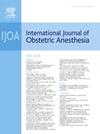围产期管理和妊娠期心血管疾病结局:澳大利亚单中心回顾性队列研究(2012-2021)
IF 2.3
3区 医学
Q2 ANESTHESIOLOGY
引用次数: 0
摘要
背景:孕产妇心血管疾病(CVD)是孕产妇死亡的主要原因。CVD患者的麻醉管理数据有限。方法:这项为期10年的回顾性队列研究纳入了508例CVD孕妇,按修改后的世界卫生组织(mWHO)风险分类进行分层,将低危组(mWHO I-II) (n = 323)和高危组(mWHO II至III-IV) (n = 185)与对照产科人群(n = 55153)进行比较。主要结局是产妇死亡率和心力衰竭,次要结局包括产妇、产科、大麻醉和新生儿并发症。结果无产妇死亡,3%的产妇发生心力衰竭。高危产妇剖腹产的可能性高于对照组(P < 0.01),低危产妇剖腹产的可能性较低(P = 1.0)。两组间产后出血率差异无统计学意义(P = 0.91)。高危组早产、低Apgar评分、死胎率均高于低危组和对照组(P < 0.01, P = 0.01, P = 0.02)。母亲心脏病影响了15%的早产决定。有1例新生儿死亡(低危组,0.3%),与对照组(0.3%)相当。分娩时硬膜外镇痛是低高危人群阴道分娩的主要镇痛方式。最常见的麻醉方式是低危患者的脊髓麻醉(61%)和高危患者的脊髓硬膜外联合麻醉(31%)。主要麻醉并发症罕见(0.2%)。结论:本研究对mWHO I-IV型心血管风险妇女的围产期管理和结局进行了研究,结果显示产妇死亡率和发病率水平较低,但高危心血管疾病的一些不良结局风险增加。临床医生应该预测高危心血管疾病患者的早产风险和专科护理需求。本文章由计算机程序翻译,如有差异,请以英文原文为准。
Peripartum management and outcomes of cardiovascular disease in pregnancy: a single-centre retrospective cohort study from Australia (2012–2021)
Background
Maternal cardiovascular disease (CVD) is a leading cause of maternal mortality. Data on anaesthetic management in patients with CVD is limited.
Methods
This ten-year retrospective cohort study of 508 pregnancies in women with CVD, stratified by modified World Health Organization (mWHO) risk category, compared lowrisk (mWHO I-II) (n = 323) and high-risk (mWHO II to III-IV) (n = 185) groups to a control obstetric population (n = 55,153). The primary outcomes were maternal mortality and cardiac failure, secondary outcomes included maternal, obstetric, major anaesthetic, and neonatal complications.
Results
There were no maternal deaths, 3 % of patients developed cardiac failure. High risk patents were more likely to deliver by caesarean delivery (CD) than controls (P < 0.01), but low risk were not (P = 1.0). There was no difference in postpartum haemorrhage rates between groups (P = 0.91). Rates of preterm birth, low Apgar score, and stillbirth were higher in high-risk patients than low-risk and control groups (P < 0.01, P = 0.01, P = 0.02, respectively). Maternal cardiac disease influenced decision for preterm birth in 15 %. There was one neonatal death (low-risk group, 0.3 %), comparable to the control population (0.3 %). Labor epidural analgesia was the predominant mode of analgesia for vaginal deliveries in low- and high-risk groups. The most frequent modes of anaesthesia for CD were spinal anaesthesia (61 %) in low-risk and combined spinal epidural (31 %) in high-risk patients. Major anaesthetic complications were rare (0.2 %).
Conclusions
This study of peripartum management and outcomes in women with mWHO I-IV cardiovascular risk demonstrated low levels of maternal mortality and morbidity, but increased risk of several adverse outcomes in high-risk CVD. Clinicians should anticipate the risk of preterm birth and need for specialised care in high-risk CVD patients.
求助全文
通过发布文献求助,成功后即可免费获取论文全文。
去求助
来源期刊
CiteScore
4.70
自引率
7.10%
发文量
285
审稿时长
58 days
期刊介绍:
The International Journal of Obstetric Anesthesia is the only journal publishing original articles devoted exclusively to obstetric anesthesia and bringing together all three of its principal components; anesthesia care for operative delivery and the perioperative period, pain relief in labour and care of the critically ill obstetric patient.
• Original research (both clinical and laboratory), short reports and case reports will be considered.
• The journal also publishes invited review articles and debates on topical and controversial subjects in the area of obstetric anesthesia.
• Articles on related topics such as perinatal physiology and pharmacology and all subjects of importance to obstetric anaesthetists/anesthesiologists are also welcome.
The journal is peer-reviewed by international experts. Scholarship is stressed to include the focus on discovery, application of knowledge across fields, and informing the medical community. Through the peer-review process, we hope to attest to the quality of scholarships and guide the Journal to extend and transform knowledge in this important and expanding area.

 求助内容:
求助内容: 应助结果提醒方式:
应助结果提醒方式:


